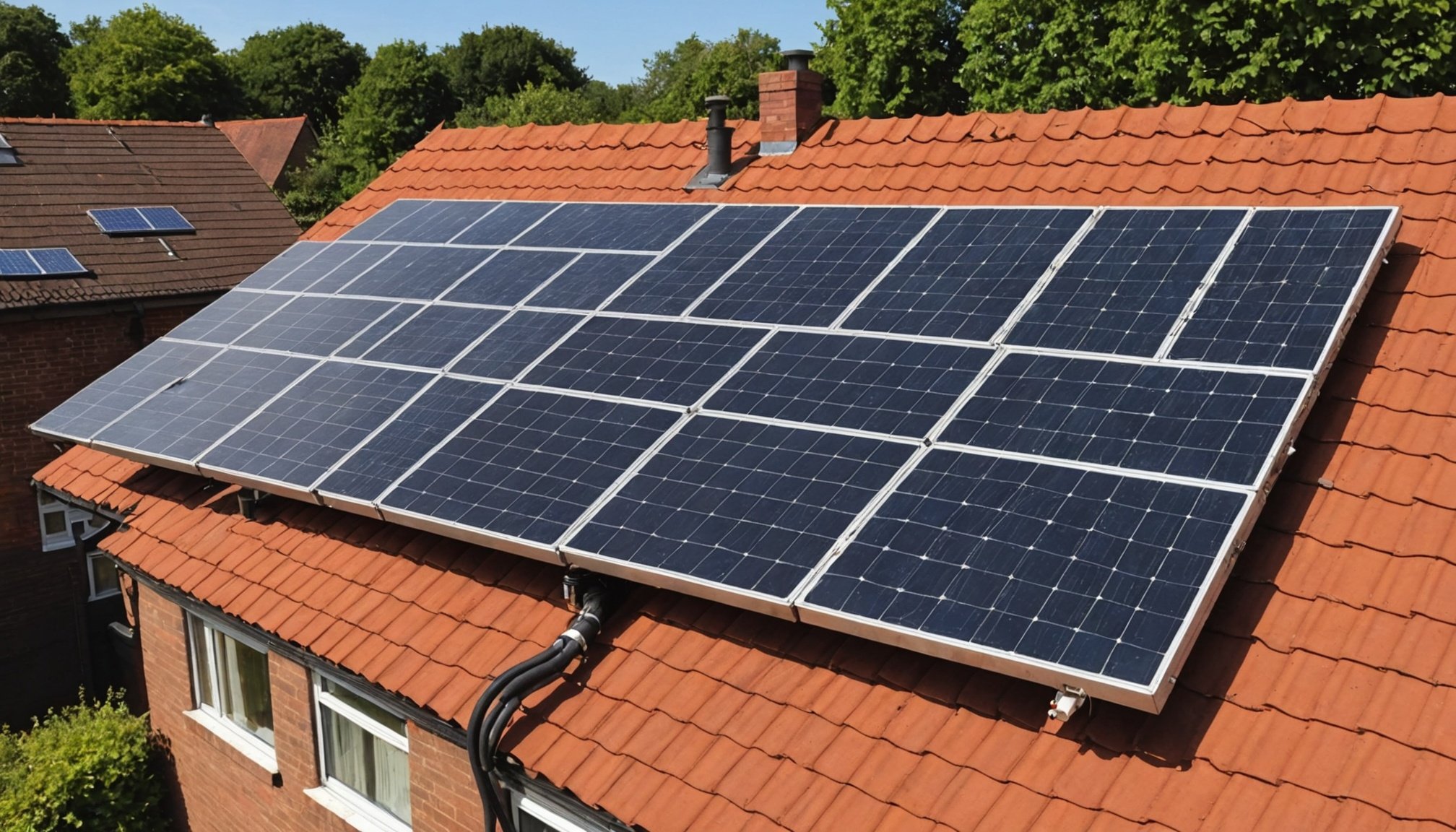The Ultimate Handbook: Safely Decommissioning Your Home Solar Panel System in the UK
Understanding the Need for Decommissioning
As the UK continues to embrace renewable energy, the installation of solar panel systems has become increasingly common. However, there comes a time when these systems need to be decommissioned, whether it’s due to a move, system failure, or the end of their lifespan. Decommissioning your solar panel system is a crucial process that ensures safety, environmental responsibility, and compliance with regulations.
Planning and Preparation
Before you begin the decommissioning process, it’s essential to plan and prepare thoroughly. Here are some key steps to consider:
Also read : Key considerations for moving your home with solar panels in the uk: a comprehensive guide
Assessing Your System
- Evaluate the Condition: Assess the current state of your solar panel system. Check for any damage, wear and tear, or obsolete components.
- Review Documentation: Gather all relevant documents, including the original installation plans, maintenance records, and any warranties or guarantees.
- Consult Professionals: If you’re unsure about any aspect of the decommissioning process, consult with a professional solar installer or a specialist in renewable energy.
Obtaining Necessary Permissions
- Local Planning Authority: Ensure you have the necessary permissions from your local planning authority. While decommissioning might not require new planning permission, it’s always best to check with your local council to avoid any potential issues[4].
Safety First
- Disconnect from the Grid: The first step in decommissioning is to safely disconnect your solar panel system from the grid. This involves switching off the main electrical supply and notifying your Distribution Network Operator (DNO), such as SP Energy Networks, to ensure the system is isolated[1].
Step-by-Step Decommissioning Process
Disconnection and Isolation
- Switch Off the System: Ensure all electrical connections are switched off and the system is isolated from the grid.
- Remove Electrical Connections: Carefully remove all electrical connections between the solar panels, inverters, and the grid.
Removal of Solar Panels
- Dismantle Mounting Structures: Remove the solar panels from their mounting structures. This may involve unscrewing or unbolting the panels from their frames.
- Transportation: Transport the removed panels to a designated area for further processing.
Disposal and Recycling
- Recyclable Materials: Solar panels are largely recyclable. Companies like PV Cycle and Recycle Solar specialize in recycling solar panels, ensuring that up to 99% of the materials are reused or recycled[1].
- Proper Disposal: Ensure that any non-recyclable materials are disposed of in accordance with environmental regulations.
Environmental Considerations and Biodiversity
Decommissioning a solar panel system also involves considering the environmental impact and potential biodiversity benefits.
Land Restoration
- Restore the Site: After removing the solar panels, restore the land to its original state or enhance it with biodiversity-friendly measures such as planting wildflowers or restoring native habitats[1].
Biodiversity Enhancement
- Enhance Local Ecosystems: Use the decommissioning process as an opportunity to enhance local biodiversity. For example, Frodsham Solar Farm plans include establishing wildflower areas and enhancing wetland habitats[1].
Energy Storage and Battery Systems
If your solar panel system includes energy storage or battery systems, decommissioning these components requires special care.
In parallel : Mastering the transition: overcoming unique challenges of moving to a thatched roof home in the uk
Battery Removal
- Safe Handling: Batteries contain hazardous materials and must be handled safely. Ensure they are removed and transported by professionals who can manage the risks associated with battery disposal.
- Recycling Options: Many battery components are recyclable. Look for specialized recycling facilities that can handle battery waste responsibly.
Integration with Future Systems
- Reuse in Other Systems: If the batteries are still in good condition, consider reusing them in other renewable energy systems. This can help reduce waste and optimize resource use.
Risks and Challenges
Decommissioning a solar panel system comes with several risks and challenges that need to be addressed.
Safety Risks
- Electrical Hazards: The primary risk during decommissioning is electrical shock. Ensure all electrical connections are safely isolated before starting the process.
- Physical Hazards: Be cautious of physical hazards such as falling from heights or injuries from sharp edges.
Environmental Risks
- Material Disposal: Improper disposal of solar panels and other materials can lead to environmental contamination. Ensure all materials are disposed of according to regulatory standards.
Financial Considerations
- Costs: Decommissioning can be costly. Plan your budget carefully and consider the costs of removal, transportation, and recycling.
- Liability: Ensure you understand any liability issues related to the decommissioning process, especially if you are selling or transferring the property.
Case Studies and Best Practices
Frodsham Solar Farm
- Comprehensive Decommissioning Plan: Frodsham Solar Farm has a detailed decommissioning plan that includes recycling all materials used in the project. This plan is part of the Development Consent Order (DCO) and ensures that the site is restored to its original state at the end of the project[1].
The Droves Solar Farm
- Pre-Application Stage: The Droves Solar Farm is currently in the pre-application stage, where the applicant is required to consult with local communities and create detailed documents about the environmental impact. This stage is crucial for ensuring that decommissioning plans are integrated into the overall project design[4].
Practical Insights and Actionable Advice
Here are some practical tips to help you through the decommissioning process:
Engage with Local Communities
- Consultation: Engage with local communities and stakeholders to ensure that their concerns are addressed. This can help in gaining support for the decommissioning process and any future developments.
Choose the Right Professionals
- Expertise: Hire professionals who have experience in decommissioning solar panel systems. This ensures that the process is carried out safely and efficiently.
Plan for the Future
- Reuse and Recycling: Plan for the reuse or recycling of materials from your solar panel system. This not only reduces waste but also contributes to a more sustainable future.
Decommissioning your home solar panel system is a complex process that requires careful planning, execution, and consideration of various factors. By following the steps outlined in this handbook, you can ensure a safe, environmentally responsible, and compliant decommissioning process.
Key Takeaways
- Safety First: Always prioritize safety during the decommissioning process.
- Environmental Responsibility: Ensure that the decommissioning process is environmentally friendly and includes measures for land restoration and biodiversity enhancement.
- Professional Assistance: Seek professional help when needed to ensure the process is carried out efficiently and safely.
- Planning and Permission: Obtain necessary permissions and plan the decommissioning process thoroughly to avoid any legal or regulatory issues.
By adopting these best practices, you can contribute to the UK’s goal of achieving net zero emissions while ensuring that your solar panel system is decommissioned in a responsible and sustainable manner.
Detailed Checklist for Decommissioning Your Solar Panel System
-
Disconnect from the Grid
-
Notify the Distribution Network Operator (DNO)
-
Switch off the main electrical supply
-
Isolate the system from the grid
-
Remove Electrical Connections
-
Disconnect panels from inverters
-
Disconnect inverters from the grid
-
Dismantle and Remove Solar Panels
-
Unscrew or unbolt panels from mounting structures
-
Transport panels to a designated area
-
Dispose of Materials
-
Recycle solar panels through specialized facilities
-
Dispose of non-recyclable materials according to regulations
-
Restore the Site
-
Restore the land to its original state
-
Enhance biodiversity with measures like planting wildflowers
-
Handle Battery Systems
-
Safely remove and transport batteries
-
Recycle battery components responsibly
-
Consult Professionals
-
Hire experienced professionals for the decommissioning process
-
Ensure compliance with local regulations and safety standards
Comparative Table: Decommissioning Solar vs. Wind Systems
| Aspect | Solar Panel Systems | Wind Turbine Systems |
|---|---|---|
| Complexity | Generally less complex due to ground-mounted panels | More complex due to the height and mechanical components of turbines |
| Safety Risks | Electrical hazards, physical hazards from falling | Electrical hazards, physical hazards from falling, mechanical hazards |
| Environmental Impact | Land restoration, biodiversity enhancement | Land restoration, potential impact on bird habitats and noise pollution |
| Material Recycling | High recyclability of solar panels (up to 99%) | Recycling of turbine components is more challenging but improving |
| Costs | Lower costs compared to wind turbines | Higher costs due to the complexity and size of turbines |
| Regulatory Compliance | Requires compliance with local planning authorities and environmental regulations | Requires compliance with local planning authorities, environmental regulations, and noise pollution standards |
Quotes from Experts
- “Decommissioning is becoming increasingly vital as a key step toward building a sustainable and innovative future. It goes beyond dismantling; it’s about transitioning to improved systems, promoting growth, and advancing sustainability.”[2]
- “The growth of small players has been key to rejuvenating old assets, but decommissioning, and the potential acceleration of it, presents increasing risks to JV partners and the UK government.”[3]
By following this handbook, you can ensure that your solar panel system is decommissioned safely, efficiently, and in a manner that supports the UK’s transition to renewable energy and net zero emissions.



